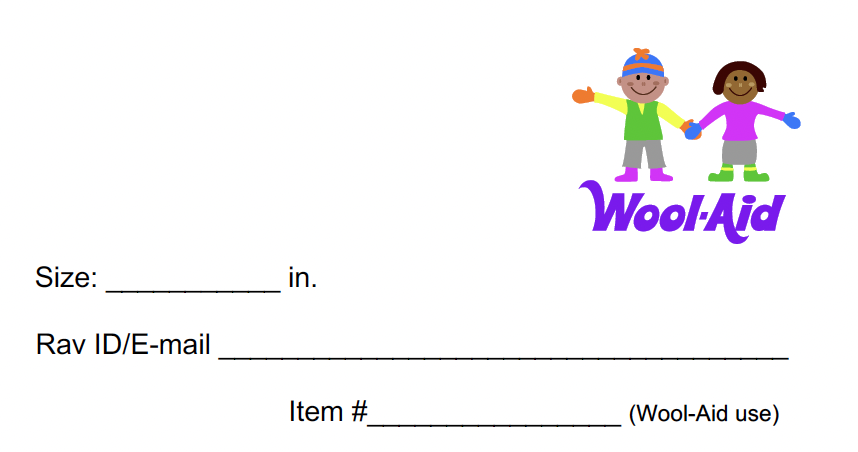Guidelines
We use wool. The children we focus on live in extremely cold climates. Wool is warm and stays warm even when it’s wet. Please use fiber that is at least 80% wool for Wool-Aid projects. Superwash wool is not required.
We create garments in a warm, dense woolen fabric. The items that we send are often worn indoors as well as outside, because homes are often very cold. Recommended patterns may call for worsted weight, aran, or bulky yarn. You may need to use a smaller needle size than is usually recommended in order to produce a dense enough fabric.
We focus on children. Our campaigns often focus on clothing for children 6 to 16 years old because they are more likely to be outside in cold temperatures. However, there is a significant need for items in smaller sizes, too, because the younger children are so very vulnerable. Items for infants through teens are always welcome.
Sweaters and vests should close securely if not a pullover style. They should have good coverage for the chest and ample length for the body. Sweater sleeves that are slightly longer than average provide more warmth and protection against the cold. Sweater Dimension Guidelines for Wool-Aid, for sizes 4 through Adult Medium, have been developed to provide appropriate dimensions for 5 key measurements of sweaters. The Guidelines consist of a measurement chart and accompanying illustrations. Please download and refer to these guidelines when making sweaters for Wool-Aid.
Hats and mittens must protect against the harsh temperatures and extreme weather conditions, so they should be heavy and dense, not lacy. A bit of extra length on the cuffs of mittens and hats can make a big difference.
— Please tie mittens together at the cuff.
Socks are one of the most-needed and most-requested items by Wool-Aid recipients. Socks of all sizes and thicknesses are needed to meet the needs of all the children that Wool-Aid serves. — Heavy socks (worn with plastic sandals or loose shoes, also worn inside where there is often no heat) should be knit in a multi-ply yarn that is worsted weight or worsted + sock yarn, unless specified otherwise. (Stranding worsted weight with sock yarn creates some lovely effects, and the sock yarn also adds durability. Single-ply yarns, such as Lamb’s Pride, are not suitable for these socks.) Socks should have standard heels (no tube socks). — Thin socks may be knit in fingering, sport, or DK yarns; yarns used for thin socks should include nylon for durability. Thin socks will fit more comfortably in standard shoes and are needed by an increasing number of our Wool-Aid kids. There are appropriate yarns available in 80% wool / 20% nylon, but it is often easier to find sock yarn with a fiber content of 75% wool / 25% nylon. The 75% wool / 25% nylon fiber content is acceptable for Wool-Aid thin socks only. (Note: We recommend using yarns that state “wool” rather than “merino,” because merino tends to be softer and less durable.) — For all socks, the leg of the sock (cuff to bottom of foot) should be as long as the foot of the sock (heel to toe), up to about 10 inches. In other words, a sock with a 9-inch-long foot should have a leg that measures 9 inches, too; a sock with an 11.5-inch-long foot should have a leg that measures about 10 inches.
— Please tie socks together at the cuff.
Blankets and 10” blanket squares follow the group’s standard guideline of 80%+ wool or animal fiber content, and may be either knit and crocheted in a dense (not lacy) fabric. We aim for a 40” × 40” size for baby blankets; blankets for older children should be approximately 40” × 60”—but a little smaller or a little larger is OK, too. Blanket squares will be seamed by volunteers; please weave in all ends before sending.
Please avoid white and very light colors. Acrylic and novelty yarn should not be used, even as an accent.
Individual campaigns may have additional requirements.
NOTE: It is very helpful if you attach a tag to each item; this will be used for assigning its individual ID number; it is also helpful if you can include the primary measurement of the item. We have created Wool-Aid tags that you can use use if you wish. They are available in both Word doc and PDF formats; please print them on heavier-than-standard paper, if possible. A sample tag is shown below:











